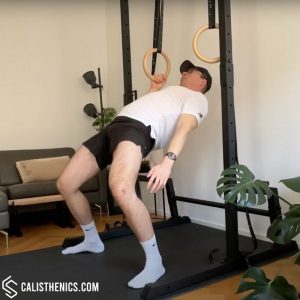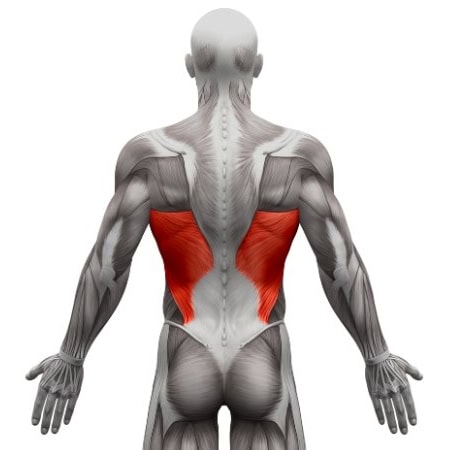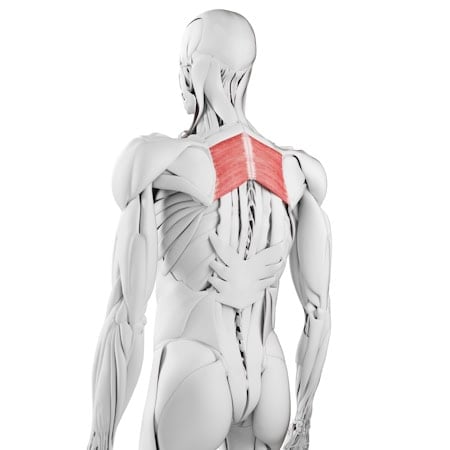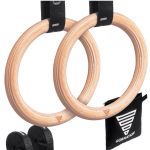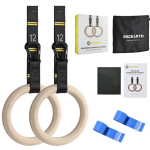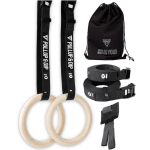One Arm Ring Row
How to do One Arm Ring Row?
The one-arm ring row is an advanced unilateral pulling exercise that develops upper-body strength, scapular control, and core stability. By using only one arm, this movement forces the body to counteract rotational forces, making it an excellent exercise for building anti-rotational core strength and addressing muscle imbalances. Unlike a standard ring row, the unilateral nature of this exercise significantly increases the demand on the working arm and shoulder stabilizers.
Before attempting the one-arm ring row, you should be comfortable with regular ring rows and have sufficient scapular control. A solid foundation in bilateral pulling exercises, including pull-ups and bodyweight rows, is recommended. This exercise can be performed with bent knees (easier variation) or straight legs (harder variation), and a staggered stance can help with balance during initial progressions.
To perform the exercise, you’ll need a pair of gymnastics rings set at an adjustable height. No additional equipment is required, but chalk can help improve grip, and a stable surface for foot placement ensures better control. This movement is an excellent addition to any calisthenics program, improving unilateral strength and shoulder integrity.
How to Perform the One-Arm Ring Row
1. Setup Position:
• Adjust one gymnastics ring to about waist height or lower for increased difficulty.
• Hold the ring with a neutral grip (palm facing inward) using one hand while extending the other arm to your side for balance.
• Lean back with your body straight, extending your legs (or bending your knees for an easier variation).
• Engage your core and glutes to maintain body tension.
2. Initiating the Pull:
• Retract your scapula and pull your chest toward the ring, keeping your elbow close to your torso.
• Avoid excessive torso rotation—keep your shoulders squared throughout the movement.
• Continue pulling until your chest reaches the ring while maintaining full-body tension.
3. Lowering Phase:
• Slowly extend your arm, lowering yourself back to the starting position with control.
• Maintain core engagement to prevent twisting.
• Allow your shoulder blade to protract at the bottom while keeping tension in the working arm.
4. Repetition and Breathing:
• Perform controlled reps, avoiding momentum.
• Inhale as you lower yourself, and exhale as you pull up.
Benefits of the One-Arm Ring Row
• Develops unilateral pulling strength, improving muscle symmetry and balance.
• Enhances core stability, as the body resists rotational forces during the movement.
• Strengthens the shoulder stabilizers, reducing the risk of imbalances and injuries.
• Builds grip endurance, as one arm must support the entire load.
• Transfers to advanced calisthenics skills, such as one-arm pull-ups and front levers.
Common Mistakes to Avoid
❌ Rotating the torso excessively: Keep your shoulders squared to maximize unilateral strength.
❌ Shrugging the working shoulder: Engage the scapula properly for efficient pulling mechanics.
❌ Using momentum: Perform the movement in a slow, controlled manner.
❌ Letting the hips sag: Maintain a strong core to keep the body aligned.
❌ Shortening the range of motion: Ensure a full stretch at the bottom and a full contraction at the top.
Tips for the proper execution of One Arm Ring Row
Keep your core engaged to prevent rotation.
Use your free arm for balance, extending it to the side or slightly forward.
Focus on scapular retraction at the beginning of each rep.
Maintain a steady breathing pattern to help control movement.
Start with a higher ring height before progressing to lower positions.
Squeeze your glutes and quads to maintain body tension.
Muscles worked when doing One Arm Ring Row
•Primary Muscles: Latissimus dorsi, middle and lower trapezius, rhomboids, rear deltoid
•Secondary Muscles: Biceps, forearms, obliques, core stabilizers
The lats and rhomboids drive the pulling motion, while the traps and rear deltoid assist in maintaining shoulder stability. The obliques and core muscles engage to counteract rotation, making this a full-body stability challenge.
Primary Muscle(s):
Secondary Muscle(s):
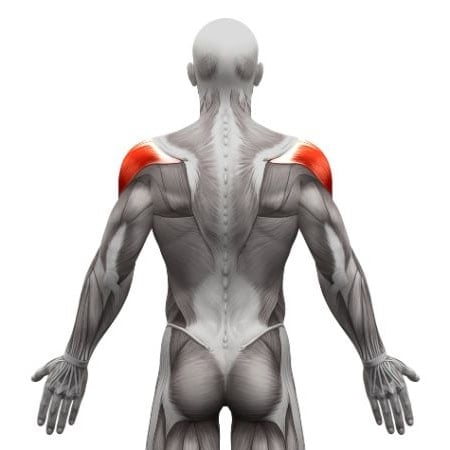
Rear delt
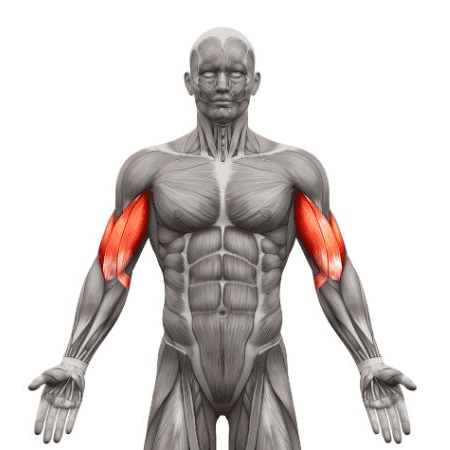
Biceps
Adjust the difficulty of One Arm Ring Row
How to make One Arm Ring Row harder?
How to make One Arm Ring Row easier?
How to make One Arm Ring Row harder?
To make One Arm Ring Row harder:
-
Straighten your legs to increase difficulty by shifting more weight onto the working arm.
-
Lower the ring to create a more horizontal body position.
-
Elevate your feet on a box to add resistance.
-
Use a slow eccentric phase, taking 3–5 seconds to lower yourself.
-
Perform the exercise with an archer grip, extending the non-working arm further to mimic a one-arm pull-up transition.
-
Add a weighted vest once bodyweight mastery is achieved.
How to make One Arm Ring Row easier?
To make One Arm Ring Row easier:
-
Bend your knees to shorten the lever and reduce resistance.
-
Raise the ring higher to allow more weight support from your feet.
-
Use a staggered stance, placing one foot forward for extra stability.
-
Perform assisted one-arm rows, lightly holding the ring strap with your free hand.
-
Practice two-arm ring rows before progressing to the unilateral variation.

